MXA RACE TEST: THE REAL TEST OF 2020 YAMAHA YZ250X CROSS-COUNTRY
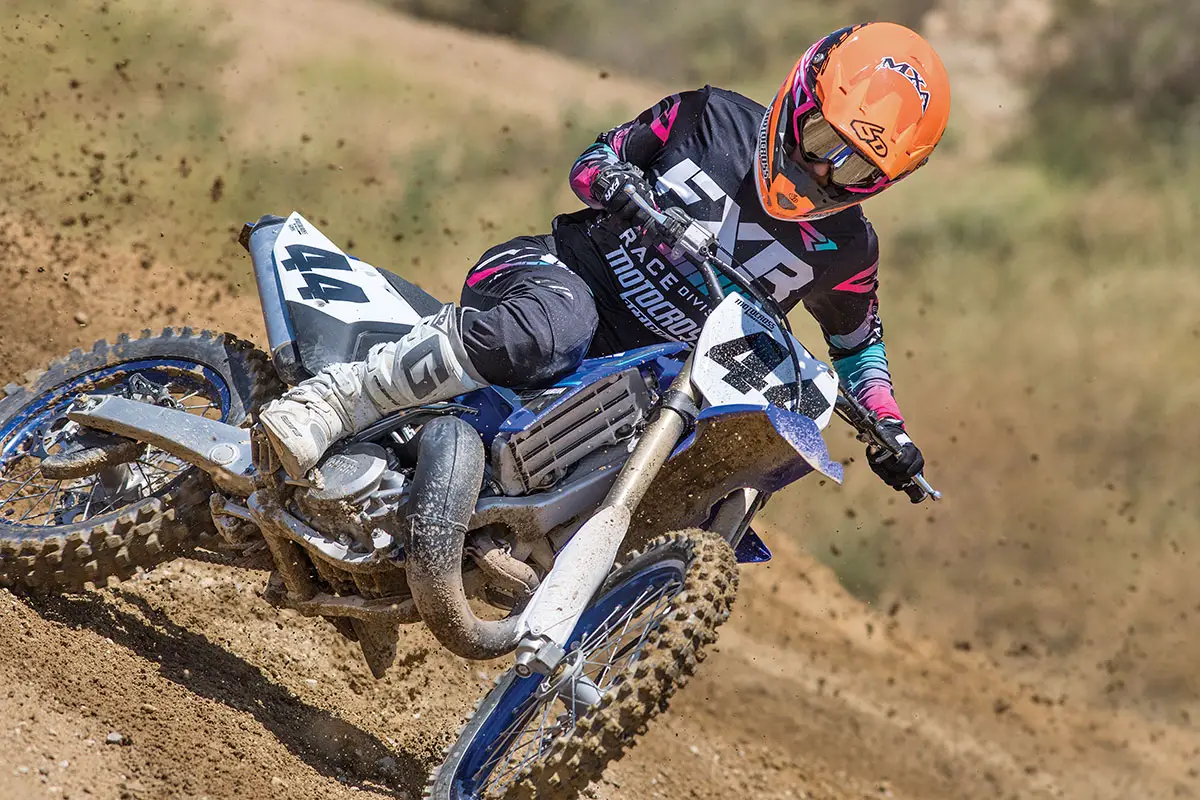
Q: IS THE 2020 YAMAHA YZ250X BETTER THAN THE 2020 YZ250 MOTOCROSS MODEL?
A: You jest. The 2020 Yamaha YZ250X is based on the YZ250, which is famous for getting a minimal number of updates over its 14-year lifespan. Given that the Yamaha YZ250X cross-country bike was first introduced in 2016, we never expected it to get any actual updates. The YZ250X and YZ250 are forced to rely on Yamaha’s R&D department to bring about change‚ and that department went to lunch a decade ago and never came back. However, there was one change in the last five years of YZ250X development. In 2017, the front brake rotor was upgraded from 250mm to 270mm. The only other noticeable updates are the wheel colors. The 2016 had silver rims, the 2017 had black rims and the 2018–2020 wheels have blue rims.
The YZ250X is a detuned YZ250 with a kickstand, 18-inch rear wheel and semi-wide-ratio gearbox.
Q: HOW MUCH DOES THE 2020 YAMAHA YZ250X COST?
A: Four years ago, the original YZ250X retailed for $7390. With currency fluctuations and inflation adjustments, the 2020 Yamaha YZ250 costs $7499, while the 2020 YZ250X costs $7599.
Q: HOW DOES THE YZ250X ENGINE DIFFER FROM THE MOTOCROSS-TUNED YZ250?

A: Here is the short list of engine differences between the YZ250X and its donor YZ250 engine.
Cylinder head and cylinder. The head volume was increased by 2.1cc, from 21.5cc to 23.6cc. This added volume reduced the compression ratio from 8.9:1 to 7.9:1. The exhaust port height was raised 0.5mm, and the power-valve shape was updated to match the exhaust port height.
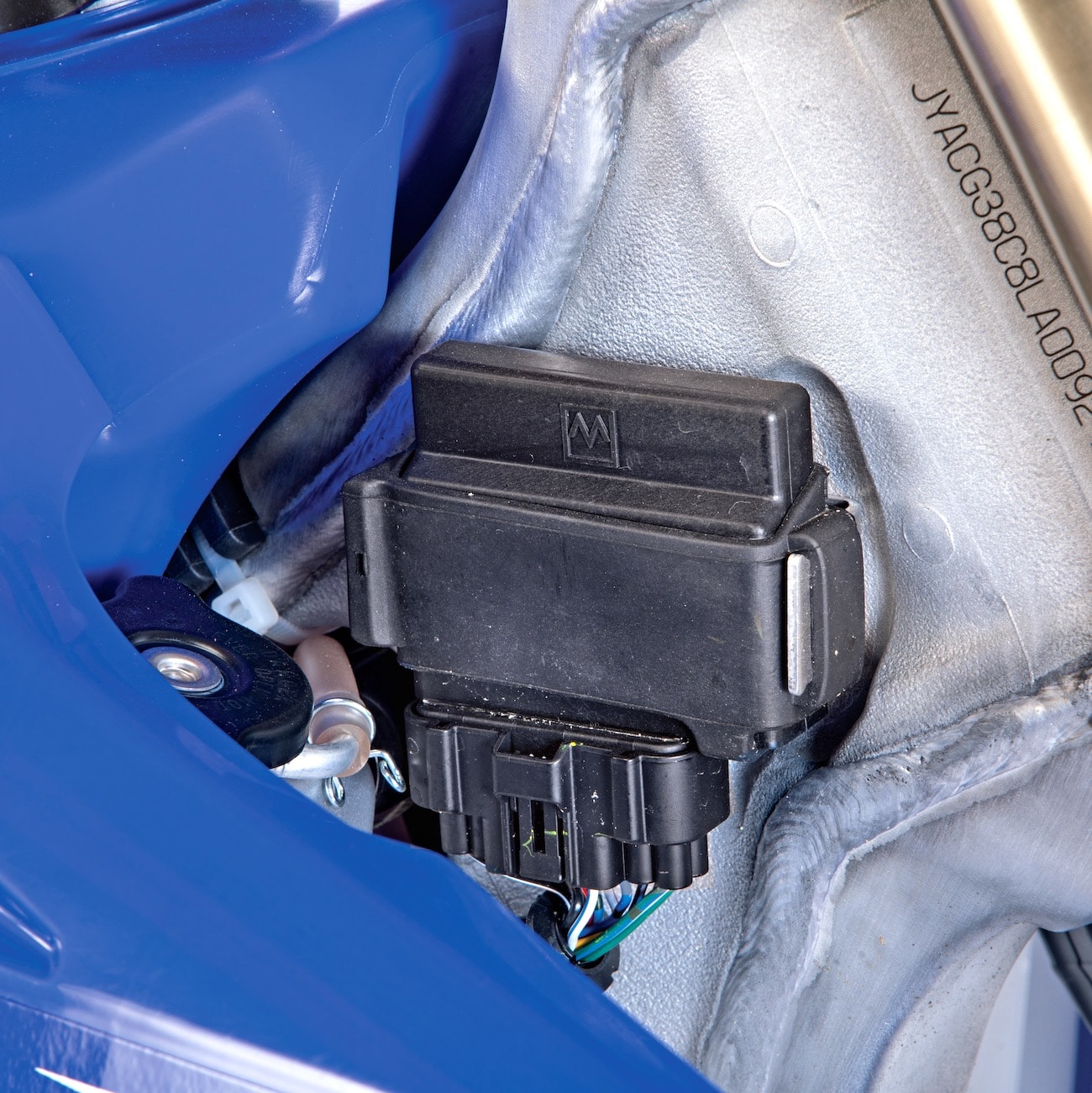
CDI. The CDI timing has been delayed in the mid-to-high rpm for a broader and gentler pull.
Power valve. The Yamaha Power Valve System’s (YPVS) governor spring and preload settings are softer to open sooner.
Exhaust pipe. The YZ250X expansion chamber is different from the YZ250 pipe. It is 35mm narrower to help it keep the vulnerable cones away from tree stumps and rocks.
Clutch. The clutch spring rate has been reduced by 10 percent for easier lever pressure.
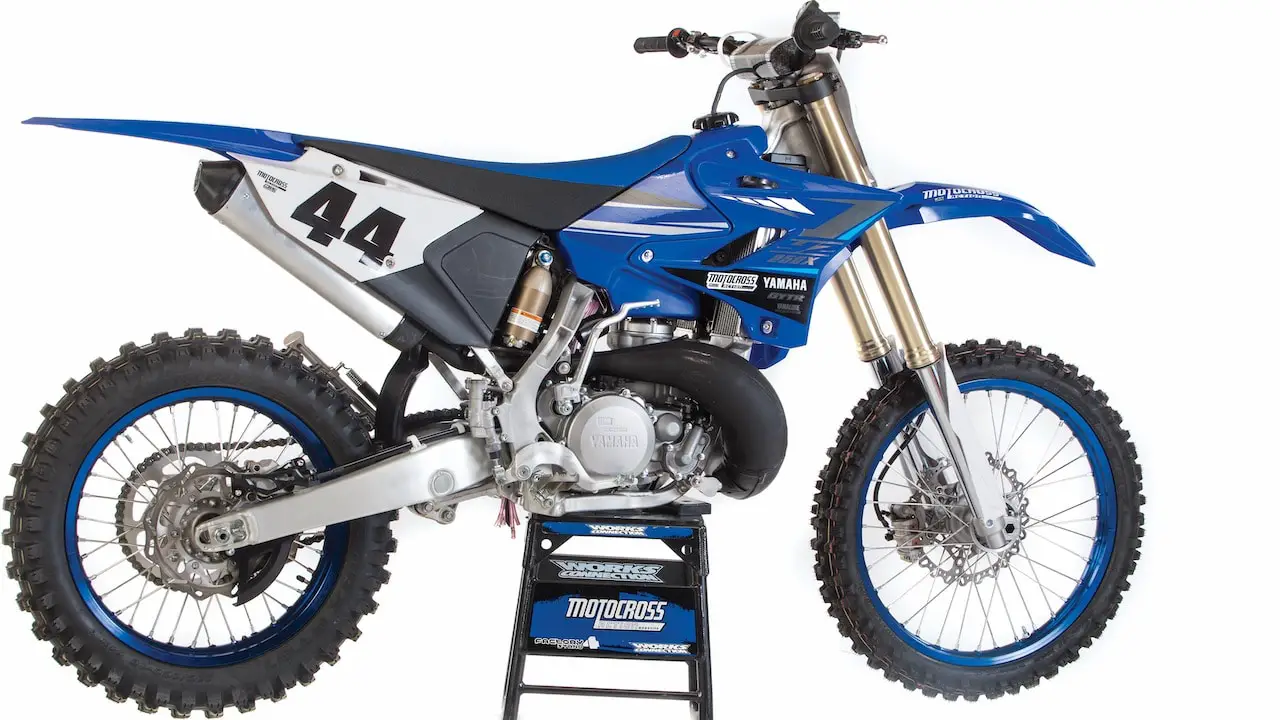
Q: IS THE 18-INCH REAR WHEEL A PLUS OR MINUS?
A: Surprisingly, MXA test riders have always believed in the charms of 18-inch rear wheels, largely because we were around during the introduction of the 19-inch rear wheels (and the 17-inch rear wheel before it). Way back in the early 1990s, AMA Pros were looking for a rim and tire configuration that wouldn’t bounce in the whoops or suffer from sidewall rollover in hard-pack Supercross corners. The tire manufacturers came up with the 19-inch tire and rim. It is important to note that an 18-inch tire and a 19-inch tire have approximately the same overall diameter; otherwise, they would change the frame geometry of the bikes they were put on. An 18-inch rear gets to its overall dimension with less rim diameter and more sidewall height, while a 19-incher has a larger rim and less sidewall height.
For the average motocross Novice, Vet or off-road racer, the 18-incher offers a bigger footprint, plusher sidewalls, added cushion and better hookup. Those are attributes that pay big dividends for off-road riders—and why virtually every off-road, enduro and cross-country bike comes with an 18-inch rear wheel.
Conversely, every motocross bike comes with a 19-inch rear wheel because it is the Supercross configuration of choice, and that status made every local racer want to switch to a 19-inch tire, even if he wasn’t hammering through Supercross whoops or turning on groomed, banked, hard-pack and bowl turns. The manufacturers complied with their customers’ wishes.
All that said, don’t sweat the 18-incher on the YZ250X, largely because you would need to have the YZ250X wheel re-laced to a 19-inch rim.
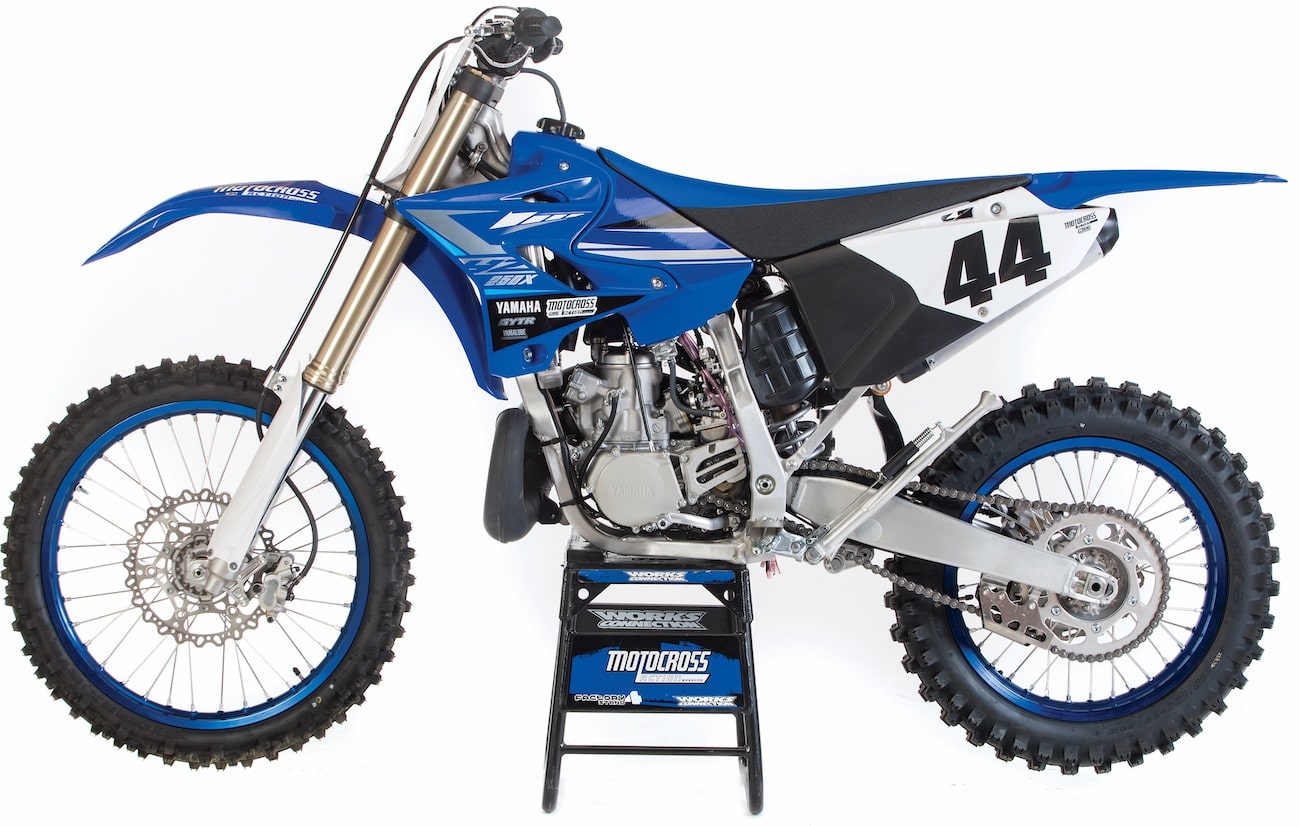 Yamaha bills the 2020 Yamaha YZ250X as a “cross-country” machine, which is more accurate than designating it a pure-bred off-road or motocross bike.
Yamaha bills the 2020 Yamaha YZ250X as a “cross-country” machine, which is more accurate than designating it a pure-bred off-road or motocross bike.
Q: HOW DOES THE YZ250X SUSPENSION DIFFER FROM THE YZ250 SUSPENSION?
A: The YZ250X offers the same industry-leading Kayaba SSS components as the YZ250, including the same spring rates front (4.3 N/mm) and rear (48 N/mm). The only thing that’s changed is that the internal shim stacks have been valved softer for better trail compliance.
Q: DOES THE YZ250X HAVE A MOTOCROSS OR OFF-ROAD GEARBOX?
A: Off-road. The Yamaha YZ250X comes with a semi-wide-ratio, off-road gearbox. First and second gears on the YZ250X are identical to first and second on the YZ250 motocross transmission. Third gear on the YZ250X is actually lower than on the YZ250 (the equivalent of adding one tooth to the rear sprocket), meaning that the gap between second and third is closer, which we wish Yamaha would do with the YZ250 motocross gearbox. Fourth gear on the YZ250X is taller than on the YZ250 (the equivalent of two teeth fewer than on the YZ250 rear sprocket); and, with the lower third-gear ratio, the jump between third and fourth gear is larger. The YZ250X’s fifth gear is so tall that it is equivalent to dropping five teeth on the YZ250 rear sprocket.
Once in motion, the MXA test riders liked the YZ250X transmission’s gear ratios from first to third better than the stock YZ250 gearbox; but, after third gear, the YZ250X gearbox wasn’t as good on a racetrack as its motocross brother. Still, the 2020 Yamaha YZ250X was set up to be a cross-country bike, and that is where the tall fourth and fifth gear ratios come in handy.
Q: IS THE 2020 YZ250X FASTER THAN THE 2020 YZ250?
A: Don’t be silly. In terms of pure speed and horsepower, Yamaha’s engineers weren’t looking to give the YZ250X the brute strength of the YZ250. Lowering the YZ250X’s compression ratio, downsizing the pipe, changing the Power Valves and backing down the ECU mapping signaled that the YZ250X would have a milder and more usable two-stroke style of power.
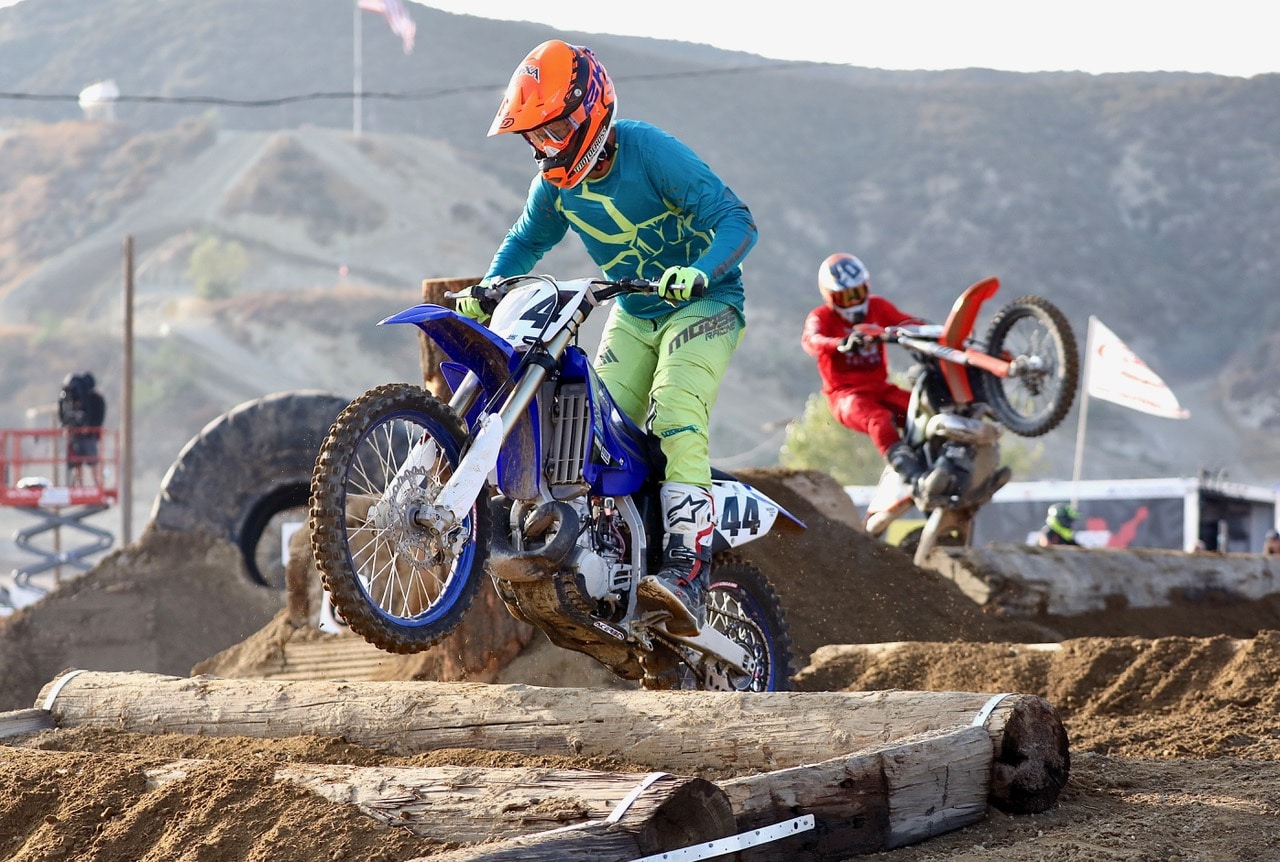 MXA didn’t just test the YZ250X for motocross, we raced the complete 2020 AMA Endurocross series on it, raced it in cross-country events and spent a lot of time in the woods in Bear Bear.
MXA didn’t just test the YZ250X for motocross, we raced the complete 2020 AMA Endurocross series on it, raced it in cross-country events and spent a lot of time in the woods in Bear Bear.
Q: HOW WAS THE YZ250X ON OFF-ROAD TERRAIN?
A: There was a time when every manufacturer made a two-stroke off-road bike, but for Honda, Kawasaki and Suzuki, those days are gone. For 2020, the Yamaha YZ250X and new YZ125X go up against 125, 150, 250 and 300 two-stroke KTMs in both carbureted and fuel-injected versions, while Husqvarna joins the fight with its TX300i fuel-injected model. We applaud Yamaha for engaging KTM and Husky in a market-share battle on the Austrians’ turf.
All of these off-road-worthy two-strokes fall into a category known as cross-country bikes. In essence, they are jack-of-all-trades dirt bikes. They can be raced in GNCC-style races, West Coast GPs, fast desert races and fun trail rides. Best of all, you can take a cross-country bike to a local motocross track and spin laps on it. What makes that possible is that the powerplant in most “cross-country” bikes is straight out of its motocross donor bike.
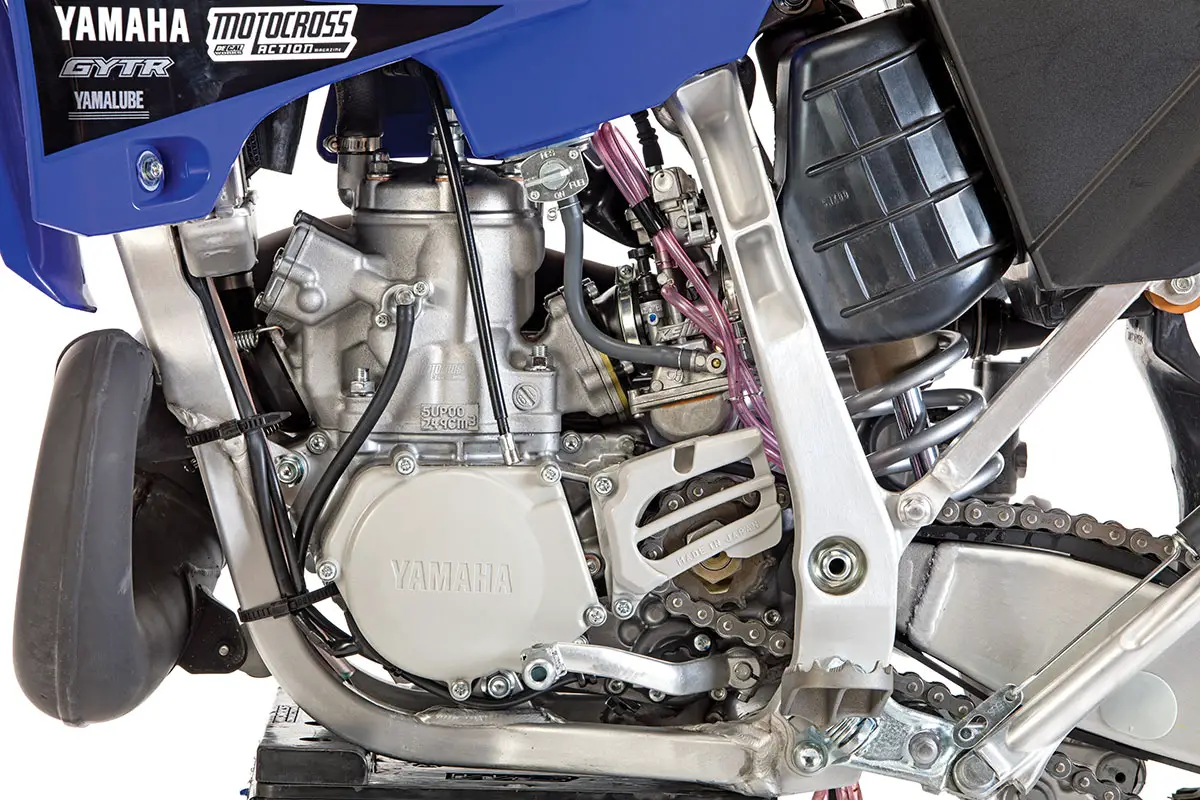
Each manufacturer decides what compromises it wants to make to skew its “X” model to one side of the scale or the other. That isn’t as easy as it sounds. If the engineers want wider gear ratios, that hurts potential motocross performance. If they want to keep the stock gas tank, that hurts the off-road viability of the bike. How soft they make the forks and shock tilts the bike away from jump-filled tracks to gentler terrain.
What compromises did the 2020 Yamaha YZ250X make? From the git-go, the YZ250X’s focus was off-road, not motocross. It has a perky low-to-mid powerband that is great for rocky trails and tight twisties, but it isn’t the powerband you want on the starting line against 39 hardcore motocross machines. The very tall fourth and fifth gear ratios make the YZ250X suited to open trail and desert riding, where the rider can just click it into fourth or fifth and cruise. As great as those tall gears are for off-road, the gaps are very big for a motocross track. The softer suspension absorbs rocks without deflection and is well-planted on slick terrain, but it bottoms on big jumps.
Where Yamaha dropped the ball as an off-road maven is with its stock YZ250 gas tank, which is too small for most long off-road rides, the lack of a skid plate to ward off rocks, and no hand guards.
Q: CAN YOU RACE MOTOCROSS ON A 2020 YAMAHA YZ250X?
A: Yes. The 2020 Yamaha YZ250X is a blast to ride. You might think that the mellower power would be a big disadvantage on a motocross track, but it really isn’t. The power delivery is so much more manageable than on the YZ250 motocross model that you can ride the YZ250X with more gusto and less trepidation. The milder hit and tractable pull of the engine, along with the ultra-plush suspension, make the YZ250X a decent motocross bike, especially for Novices, Vets and riders who want to do double- or triple-duty on the same bike. One caveat: if you buy a YZ250X and port the cylinder, mill the head and add an aftermarket exhaust, you might as well have bought a YZ250 and saved the money.
Q: HOW SHOULD YOU GEAR IT FOR MOTOCROSS RACING?
A: Most MXA test riders opted for the stock 14/50 gearing for motocross and off-road combined. It was just easier to use, and the penalty wasn’t too great in either discipline; however, there were MXA test riders who went to a 51-tooth rear sprocket. They were willing to live with tighter gaps between first, second and third, because it gave them more drive to get into fourth gear without falling off the pipe. This was a trade made for a closer jump to fourth gear.
Q: HOW DID WE LIKE THE OFF-ROAD SUSPENSION SETTINGS FOR MOTOCROSS?
A: No surprise. The suspension was soft, but we already figured it would be. It rode low in the stroke and had a harsh feeling on the consecutive chatter of a motocross track. But, the great thing is that it never felt like it bottomed. We did a band-aid fix that made all the difference in the world. We added 10cc of oil to each fork leg, which helped keep the forks out of the harshest part of the stroke. Yes, it was too soft for Pro riders or tracks with lots of big jumps, but we were still able to cut competitive lap times on the YZ250X. And many of our Vet test riders felt that the YZ250X suspension setup favored their speed more than the YZ250 forks.
Q: WHO WOULD BE HAPPY WITH A 2020 YAMAHA YZ250X?
A: Someone willing to make compromises, because that is what the YZ250X is all about. There are better off-road two-strokes, including ones with six speeds, fuel injection, bigger gas tanks, skid plates and hand guards. There are better motocross-specific two-strokes, including ones with stiffer suspension, tighter gear ratios, more power and less weight. If you are a motocross specialist or a guy who loves plonking through the trees, you can find better bikes than this. It’s just that the closer a bike gets to being perfect for one discipline, the worse it is for the other.
The 2020 Yamaha YZ250X isn’t perfect; it is workmanlike. It can get the job done—off-road or on a racetrack. Its imperfections make it the perfect bike for a guy who wants to do all kinds of riding on one 250cc two-stroke.
Q: WHAT DID WE HATE?
A: The hate list:
(1) Gearbox. It has a great first, second and third gear for motocross, but the taller fourth and fifth are less than optimal on a race track. For off-road riding, the YZ250X gearbox is okay—definitely not as good as a semi-wide ratio six-speeder but better than on bikes that make the stock motocross gearbox their off-road gearbox.
(2) Gas tank. In a cross-country race or on a long trail ride, the YZ250X will have a hard time completing a 40-mile loop without running out of gas. There are oversized aftermarket gas tanks available. The X has the same fuel capacity as the YZ250, but the X offers a reserve fuel valve that kicks in when 0.5 gallons are left in the tank. That is typically enough warning for you to know that you are going to run out of gas soon but not always enough gas to get you back to your truck.
(3) Clutch. It should be noted that we run stiffer clutch springs on our YZ250 two-strokes, so we were less than enamored by the 10-percent softer clutch springs on the identical clutch in the YZ250X.
(4) Rear wheel. The terrain-specific, 18-inch, Dunlop Geomax AT81 tires are off-road-specific. For motocross, run your favorite premium motocross tires—if they come in an 18-inch size.
(5) Add-ons. The X doesn’t come with hand guards or a skid plate, but it does have a D.I.D. O-ring chain and spring-loaded aluminum side stand.
Q: WHAT DID WE LIKE?
A: The like list:
(1) Seat height. The YZ250X has a 1-inch lower seat height when compared to the YZ250 (38.2 inches versus 39.1 inches). Given that the YZ250X uses the same frame, wheels, suspension components, shock linkage and plastic, we don’t know where the inch came from.
(2) Maintenance. Anybody with a modicum of mechanical skill can keep a YZ250 two-stroke running.
(3) Parts. The MXA wrecking crew doesn’t believe that two-strokes are more reliable than four-strokes. It is just that when unreliability rears its ugly head, a two-stroke owner spends less dough on pistons, rings and gaskets—and can do the work himself.
(4) Third gear. Bringing third gear closer to second has been on our wish list for the YZ250 for many years. Now that our prayers have been answered on the X, we hope to see the change on the YZ sometime in the near future (but changes to the YZ250 haven’t been in the cards over the last 14 years, so we are just dreaming).
Q: WHAT DO WE REALLY THINK?
A: The 2020 Yamaha YZ250X is billed as a cross-country machine, but Yamaha’s business plan did not include going whole hog to achieve it. Without a six-speed gearbox or a larger fuel tank, it is immediately handicapped for most types of technical cross-country riding or day-long trail rides. If you are a pure off-road rider or hardcore motocrosser, there are better bikes for you.
The YZ250X isn’t the best 250cc two-stroke off-road racer or the best 250cc two-stroke motocross bike‚ but it might be the best all-around 250 two-stroke for a guy who wants to ride off-road this weekend and at the track next weekend.
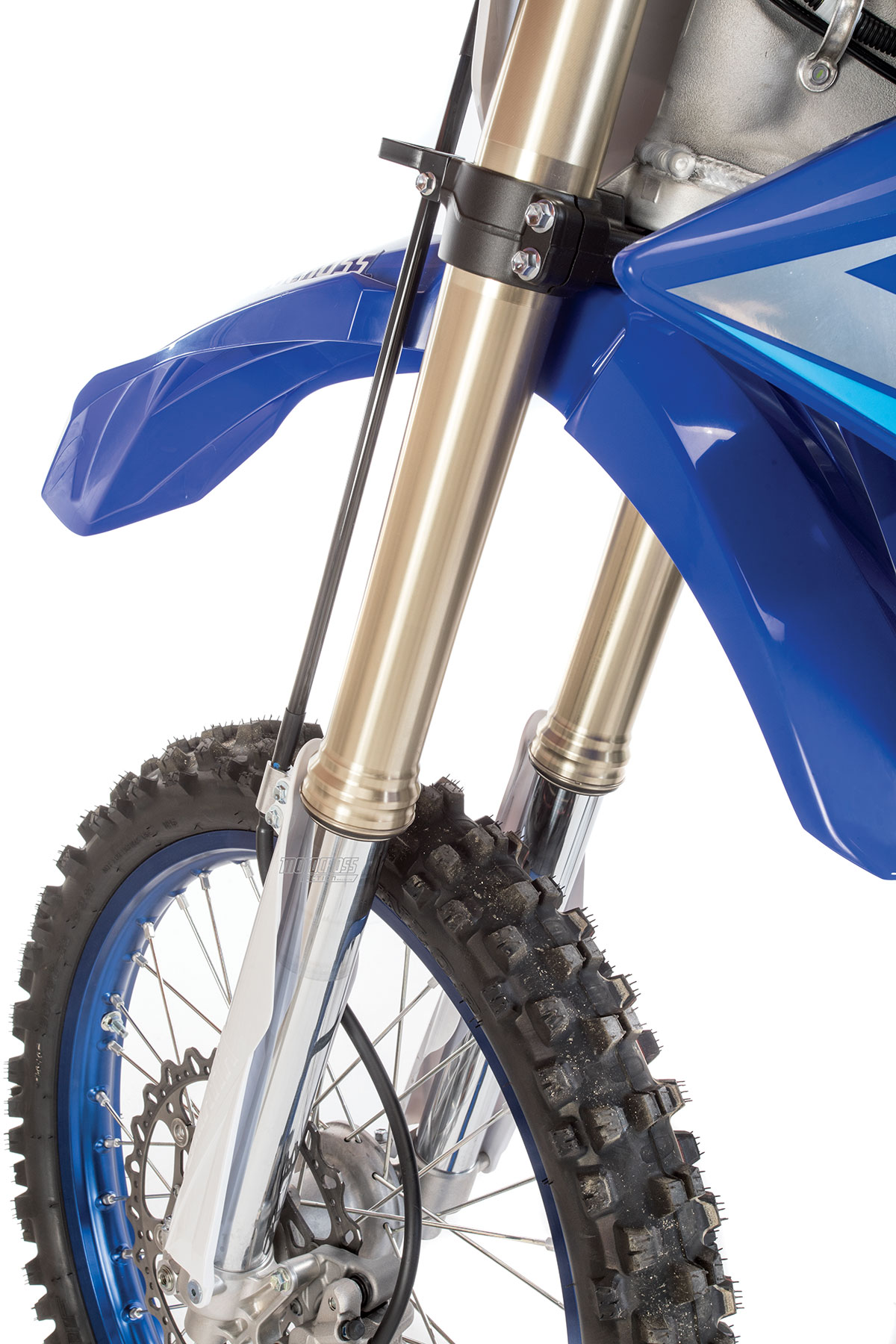
MXA’S YAMAHA YZ250X SETUP SPECS
This is how we set up our 2020 Yamaha YZ250X for the motocross track. We offer it as a guide to help you find your own sweet spot.
KAYABA SSS FORK SETTINGS
Most MXA test riders stayed close to the stock clicker settings (after we added 10cc of oil to each fork leg), with the faster riders going in two to five clicks. For hardcore racing, we ran this setup on the 2020 Yamaha YZ250X (stock clickers are in parentheses):
Spring rate: 4.3 N/mm
Compression: 9 clicks out (13 clicks out)
Rebound: 10 clicks out
Fork-leg height: 5mm
Notes: The SSS components did not feel as if they were bottoming out, which was a huge confidence booster for all conditions. For motocross, we added 10cc of oil to each fork leg, which is exactly what we did on our Yamaha YZ250FX four-stroke.
KAYABA SSS SHOCK SETTINGS
Our testers liked the movement on the shock, but felt that it was a bit underdamped. They went in a few clicks with the rebound and compression to slow it down and keep it up in the stroke. For hardcore racing, we recommend this shock setup for the 2020 Yamaha YZ250X (stock specs are in parentheses):
Spring rate: 48 N/mm
Race sag: 105mm
Hi-compression: 1-3/4 turns (1-1/2 turns out)
Lo-compression: 9 clicks out
Rebound: 9 clicks out (11 clicks out)
Notes: The shock is the same as on the YZ250, including the spring rate. The only thing different is the shim stack‚ which can be firmed up with compression and rebound clicks.
YAMAHA YZ250X JETTING
Here are MXA’s recommended jetting specs (when changed, stock specs are in parentheses):
Main: 178
Pilot: 50
Needle: N3EW
Clip: 2nd from top
Air screw: 1 turn
Notes: The 2020 YZ250 jetting is on the edge, but the X is a litle farther to the safe side. If you hop up the YZ250X or add an aftermarket exhaust pipe, you will need to go to a bigger 180 main or add a dash of VP C-12 fuel to your pump gas. Other than that, the YZ250X jetting is basic, simple and effective. The air screw is very sensitive from 1/2 turn to 1 turn out.


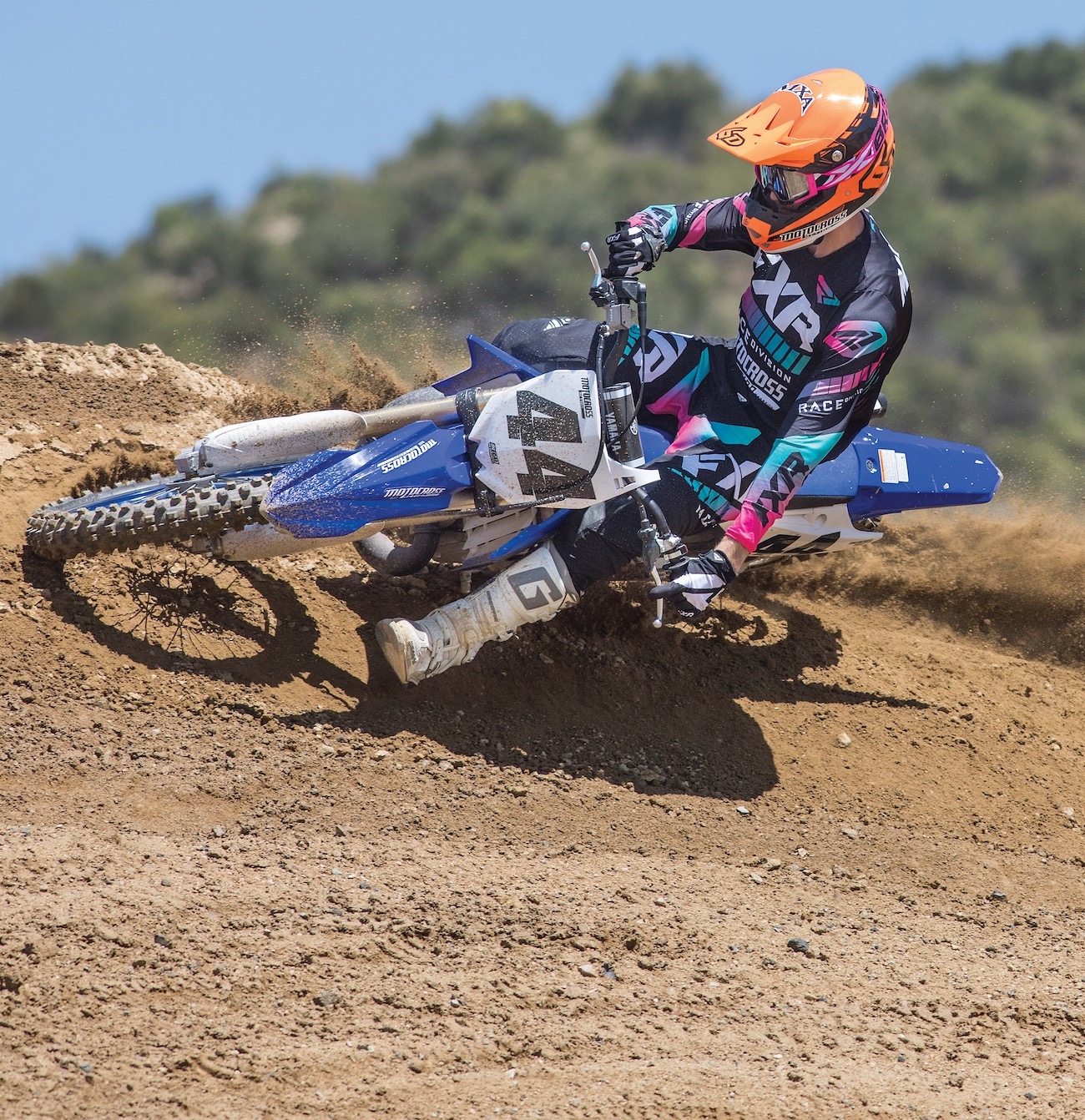

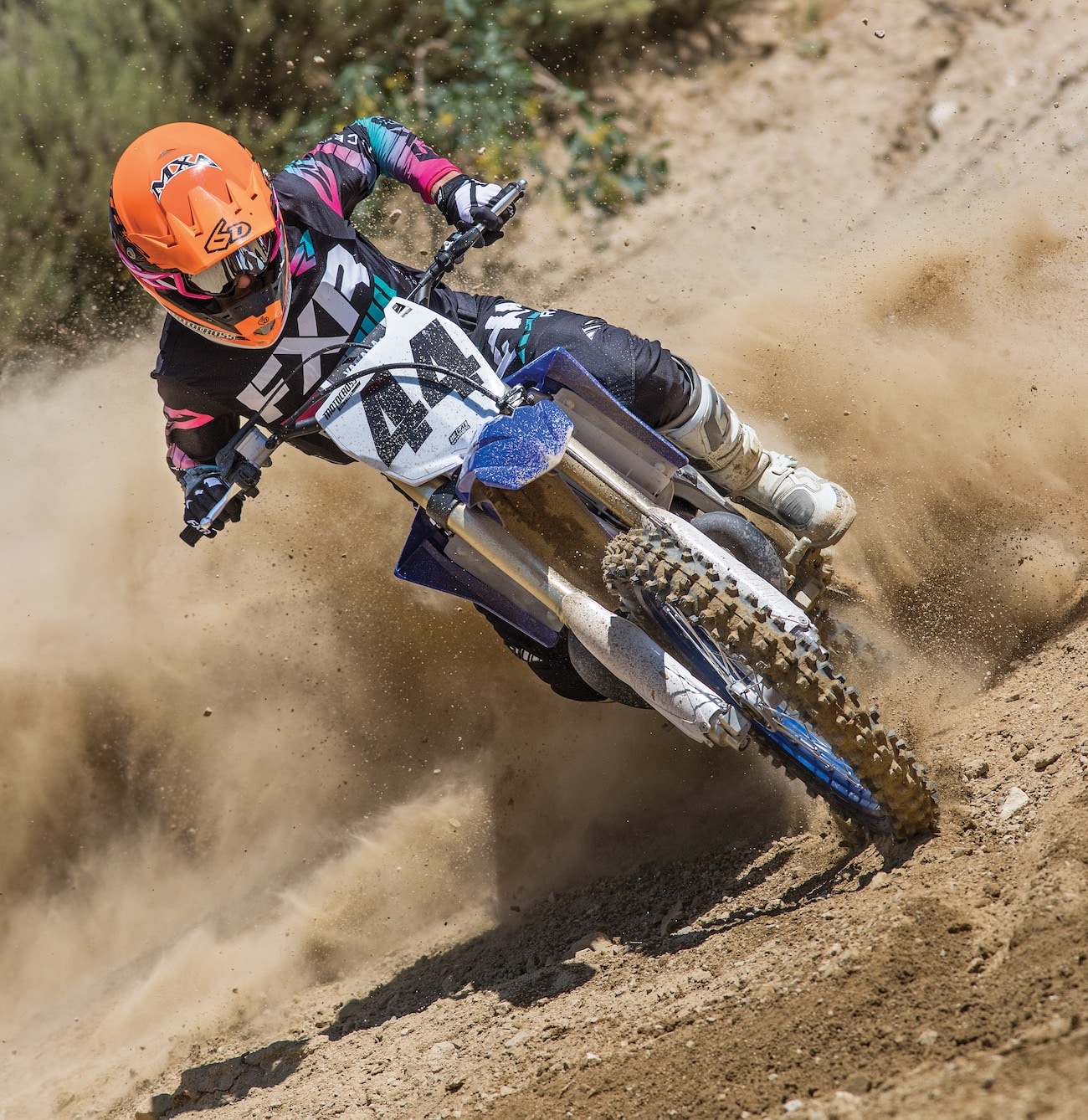
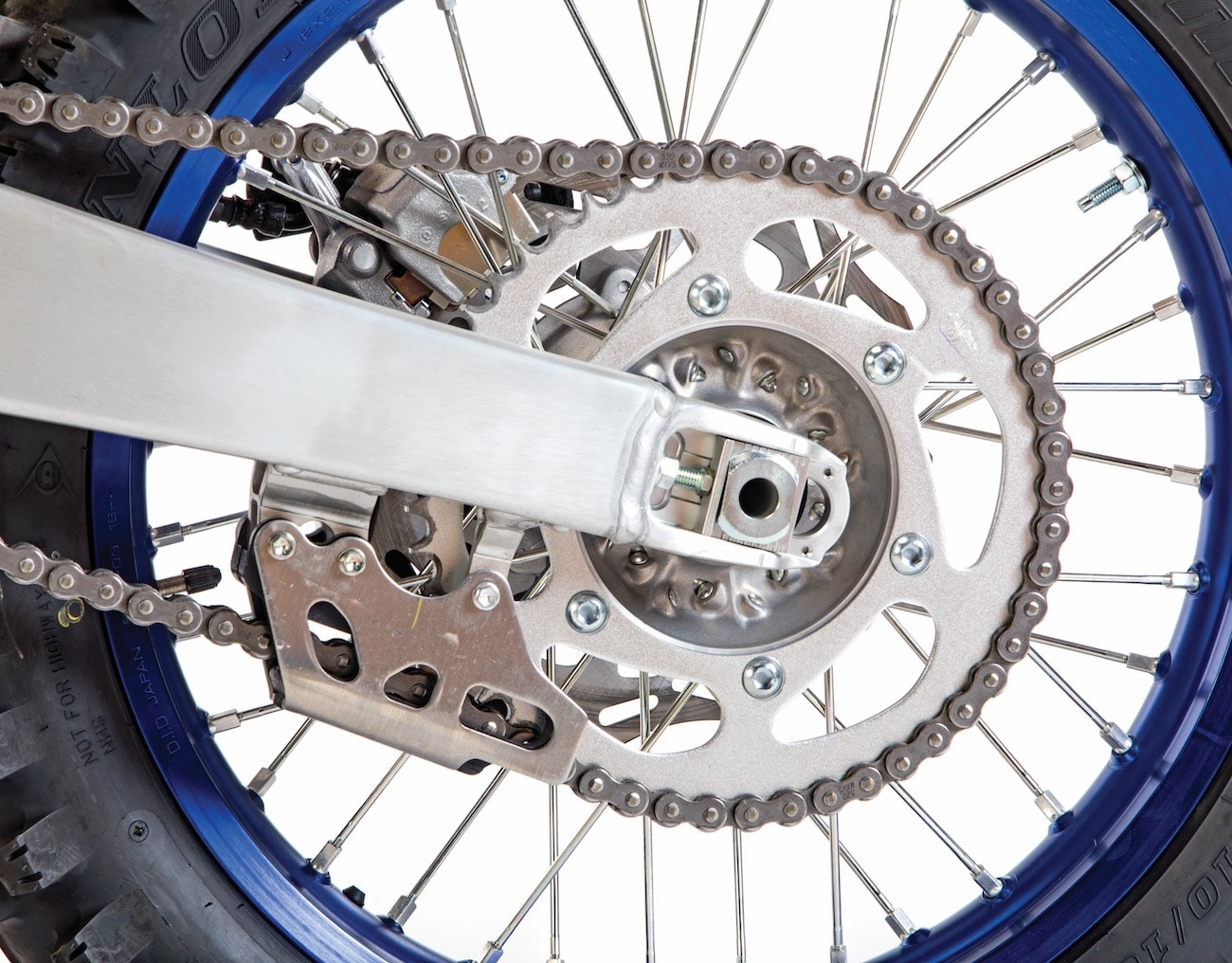
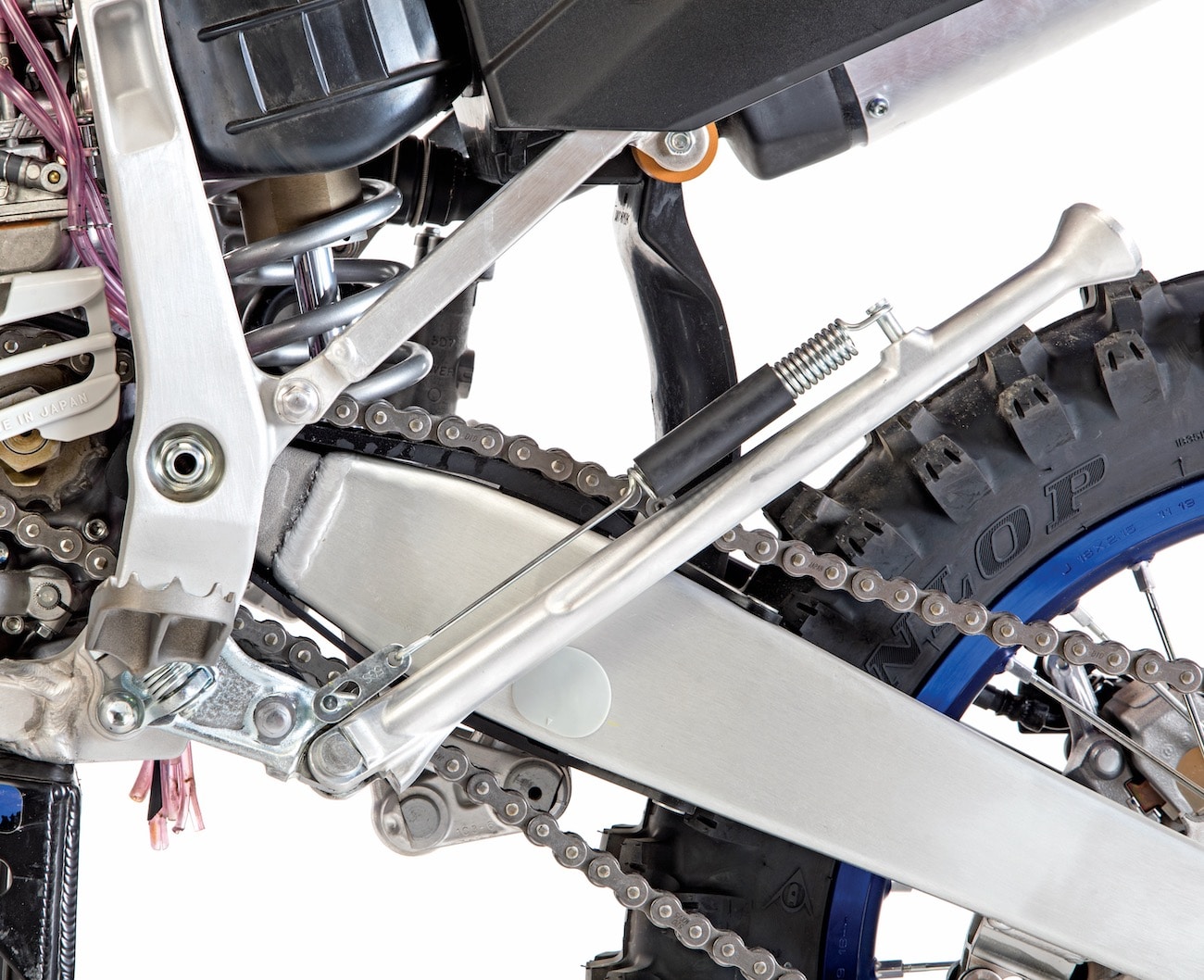




Comments are closed.